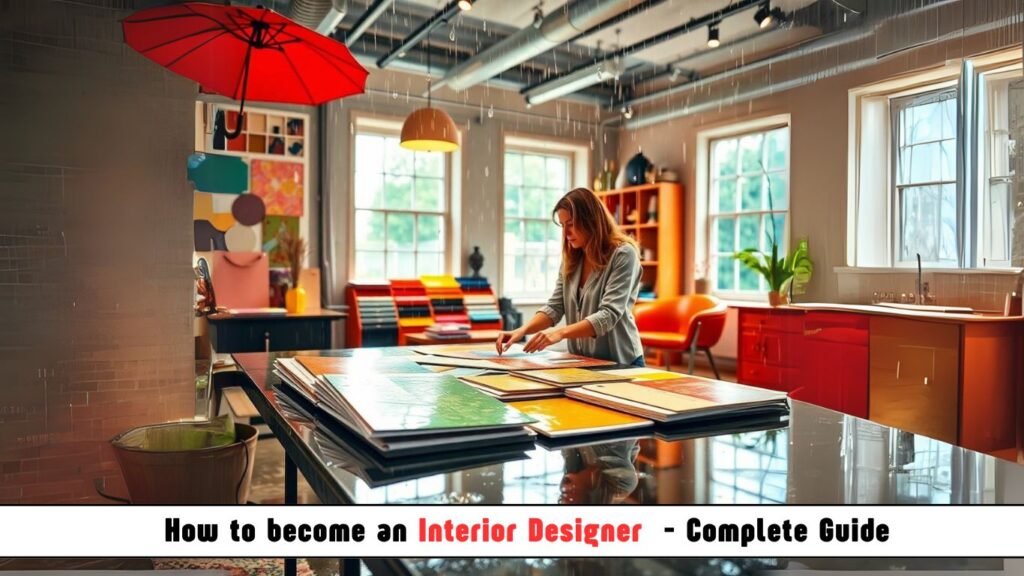
Introduction: The Art of Shaping Spaces
Interior design transforms empty rooms into functional, beautiful environments that influence how we live, work and feel. From ancient palaces to modern smart homes, interior designers blend aesthetics with practicality to create spaces that tell stories.
This comprehensive guide explores everything about interior design careers – from its historical roots to today’s six-figure salaries, emerging technologies, and how to launch your own design firm.
1. What is an Interior Designer?
Interior designers are space architects who:
- Enhance functionality, safety and aesthetics of interiors
- Select color schemes, furnishings, lighting and materials
- Create harmonious environments for living, working or commercial use
Key Specializations:
- Residential (Homes, apartments)
- Commercial (Offices, hotels, restaurants)
- Healthcare (Hospitals, clinics)
- Sustainable Design (Eco-friendly spaces)
- Set Design (Film, theater)
2. Historical Evolution of Interior Design
Ancient Beginnings (3000 BC – 1600 AD)
- Egyptian Era: Ornate palaces with gold accents and murals
- Roman Period: First use of interior courtyards and mosaics
- Middle Ages: Tapestries for insulation and decoration
Renaissance to Industrial Revolution (1400-1800)
- Baroque Period: Dramatic theaters and churches
- Victorian Era: Cluttered, dark wood interiors
- Arts & Crafts Movement (1880s): Handmade furniture revival
Modern Era (1900-Present)
- Bauhaus School (1919): “Form follows function” philosophy
- Mid-Century Modern (1950s): Clean lines and organic shapes
- 21st Century: Smart homes and biophilic design
3. Roles & Responsibilities
Space Planning
- Creating functional floor plans
- ADA compliance and universal design
Material Selection
- Choosing sustainable surfaces and textiles
- Lighting design for ambiance and task needs
Project Management
- Budgeting and timeline coordination
- Contractor/vendor communications
Technical Skills
- AutoCAD for technical drawings
- 3D rendering (SketchUp, Revit)
- Building codes and regulations
4. Interior Design Salary Outlook (2024)
| Position | Entry-Level | Mid-Career | Senior |
|---|---|---|---|
| Residential Designer | $45,000 | $65,000 | $90,000+ |
| Commercial Designer | $50,000 | $75,000 | $110,000+ |
| Healthcare Designer | $55,000 | $80,000 | $120,000+ |
| Independent Designer | Varies (Avg. $75-$150/hr) |
Top Paying Industries:
- Corporate office design
- Luxury hospitality
- Healthcare facilities
- Government projects
5. Education & Certification Paths
Formal Education Options
- Associate Degree (2 years, technical skills)
- Bachelor’s Degree (4 years, CIDA-accredited)
- Master’s Degree (Specializations like lighting design)
Essential Certifications
- NCIDQ (North America)
- CID (California)
- LEED (Sustainable design)
Self-Taught Route
- Master design software (AutoCAD, SketchUp)
- Complete online courses (Coursera, MasterClass)
- Build portfolio through pro bono work
6. Launching Your Career
Step 1: Develop Core Competencies
- Study color theory and spatial relationships
- Learn building systems (electrical, HVAC basics)
Step 2: Build Your Toolkit
- Digital: Adobe Creative Suite, Revit
- Physical: Material samples, measuring tools
Step 3: Gain Experience
- Intern at design firms
- Work with home staging companies
- Assist photographers on interior shoots
Step 4: Specialize
- Kitchen/bath design
- Aging-in-place modifications
- Hospitality design
7. Future of Interior Design
Emerging Technologies
- VR/AR Design Visualization: Client walkthroughs
- AI Space Planning: Algorithmic furniture arrangements
- 3D Printed Decor: Custom architectural elements
Sustainable Innovations
- Mycelium (mushroom) based materials
- Zero-waste furniture design
- Energy-efficient smart glass
Growing Specializations
- Wellness design (air/water purification systems)
- Metaverse space design
- Post-pandemic workspace solutions
Conclusion: Designing Your Future
Interior design offers creative fulfillment with strong career prospects. As environments become more technologically integrated and sustainability-focused, skilled designers will be in high demand.
Your Next Steps:
- Start sketching room layouts daily
- Volunteer to redesign a friend’s space
- Build a digital portfolio website
- Connect with local design associations
The spaces we inhabit shape our lives – will you help design tomorrow’s inspirational environments?













Post Comment